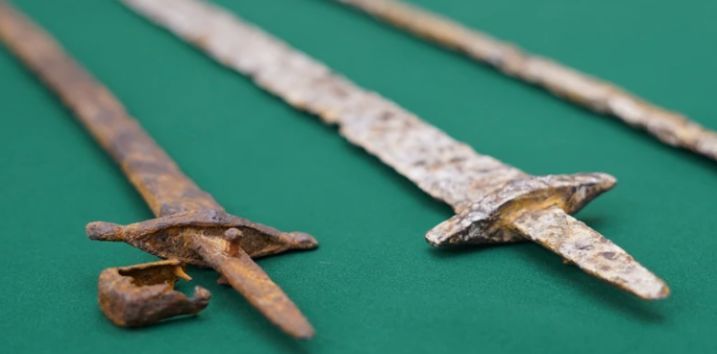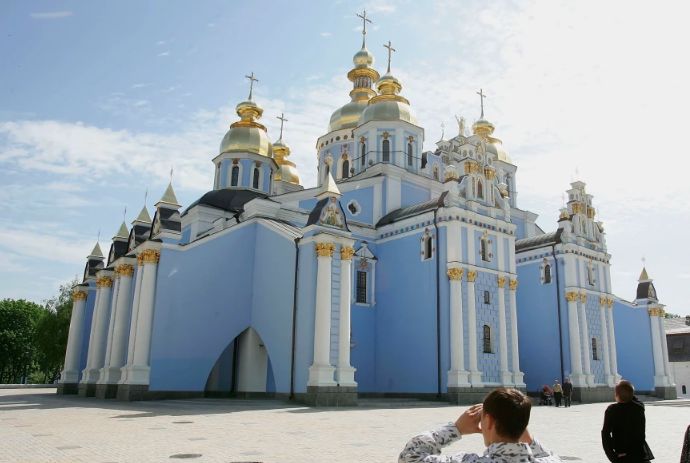By Eric Vandenbroeck
and co-workers
Russian Looting As A Potential
War Crime
Although immediate
human needs, the equipping of Ukraine’s military, and the quest for an end to the
war inevitably capture global attention, Ukrainian cultural objects also should
be protected and preserved. This is another form of resistance against Putin’s
assault on democracy.
On Friday morning,
three swords that looked to have spent much of their lives underground were
laid carefully on a green cloth draped over a table at the Ukrainian Embassy in
Georgetown, Washington, D.C. For over a year, Washington has been singularly
preoccupied with getting weapons to Ukraine, so when an invitation arrived from
the Ukrainian Embassy to a repatriation ceremony for a stone axe and three
swords.

The weapons presented
at the embassy were purloined artifacts sent from Russia, seized by U.S.
Customs and Border Protection (CBP) agents at New York’s John F. Kennedy (JFK)
International Airport. Experts from the Institute of Archaeology at Ukraine’s
National Academy of Sciences have dated the swords to the fifth or sixth century
B.C. and the polished flint axe head to the third century B.C. According to a
handout shared by the embassy, all have been deemed to hail from territory
belonging to present-day Ukraine.
Five CBP officers in
full uniform milled around with a small handful of reporters, many of whom
worked for Ukrainian outlets. There was surprisingly little standing in the way
of the priceless artifacts and the room full of journalists. A CBP evidence
bag, the temporary home of the seized axe head, sat empty in a side room on a
chair with a black pea coat—possibly belonging to one of the reporters—thrown
over it.
More than a million
pieces of mail come in through that airport every day, Frank Russo, CBP’s
director of field operations for New York, explained in opening remarks.
“Finding the needle in the haystack, finding these items, is not easy,” he
added, attributing the successful operation to the agency’s collaboration with
the National Targeting Center and U.S. Homeland Security investigations.

The importer is known
to the government “who looks to do this repeatedly,” Russo said. Are they
Russian nationals? He couldn’t say but added that they were “from that area,
for sure.” Little else was offered regarding this apparent black market
of ancient Ukrainian artifacts.
The seized items
arrayed at the Ukrainian Embassy on Friday are just the first to have been
identified from more than 20 packages originating with the same sender in
Russia’s Krasnodar Krai region, which abuts the Crimean Peninsula, according to
a Ukrainian diplomat who asked to remain anonymous. They said CBP had
intercepted all at JFK and Newark airports between July and September of last
year, and the work is ongoing to clarify whether they originated from Ukraine.
Like much else about this case, it’s unclear whether the items were seized
during the current war or where they were taken from.
Remarks by Oksana
Markarova, the Ukrainian ambassador to the United States, set the
importance of the discoveries in the context of the current war. “We know this
fight is about our territorial integrity and sovereignty. We know this fight is
about our democracy and freedom,” Markarova said. “But it is also a fight about
our cultural identity.”
As Russia has waged
war on Ukraine in a bid to kneecap the country’s independence, its troops have
looted museums, art galleries, and cathedrals in occupied areas. Some experts
have described it as the biggest heist since the Nazis
plundered Europe during World War II. At least 10,000
artworks are estimated
to have been taken from the Kherson Regional Art Museum during the city's
occupation, according to Human Rights
Watch, which has described
the looting as a potential war crime.
For updates click hompage here